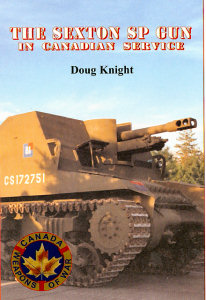
The Sexton SP Gun in Canadian Service Book Review
By Cookie Sewell
| Date of Review | January 2007 | Title | The Sexton SP Gun in Canadian Service |
|---|---|---|---|
| Author | Doug Knight | Publisher | Service Publications |
| Published | 2006 | ISBN | 1-894581-32-6 |
| Format | 24 pages, softbound | MSRP (CDN) | $9.95 |
Review
One of the myths of the Second World War which has unfortunately come down to us is that the Canadians copied many US designs, when the fact of the matter is exactly the opposite. The Ram tank was an original idea, and not a copy of the Sherman; likewise, the Sexton was an original design and not a copy of the M7 Priest.
In March 1942 the Canadians, who were then primarily modeled on the British Commonwealth pattern of equipment and unit organization, decided to create self-propelled artillery to support their own forces and if needed to provide support to the British Army. Having the mechanically reliable and flexible M3 Medium Tank chassis available, they experimented with fitting the then standard 25-pdr field gun to it as a self-propelled weapons system. Three months later Montreal Locomotive Works (the Canadian subsidiary of the famous ALCO locomotive company in the US) produced a wooden mockup followed by a prototype in July. After testing and getting the kinks out of the design, it was shipped to the UK for trials.
Even while it was under testing, the Canadian government ordered 84 of the new guns for their own artillery units. Fitted with a tank compass so the driver could get a rough bearing alignment of the gun for firing, the system was shown to work well. Tests at Larkhill in the UK showed the gun to be amazingly easy to deploy and operate, coming into action in 20 seconds and being able to change firing positions in less than 90 seconds. The comparative tests were such that the British decided to stop use of the American M7, now dubbed the "Priest" and opt for the ammunition-compatible 25-pdr SP gun. In May, the new weapon was given the formal designation "Sexton" (following the Priest, the British gave all of their SP guns clerical names, such as the Valentine based "Bishop" and the postwar 105mm "Abbot.")
Sextons were organized into three-battery regiments of eight guns per battery (two sections of four each) or 24 guns total. Later, Ram OP Tanks were provided along with "defrocked" Sextons as Gun Position Officer's vehicles for battery level fire control. On occasion these regiments were refitted with M7 Priests, such as for D-Day, but the preferred vehicle was the Sexton. The British and Canadians preferred the 25-pdr as it outranged the M2 series 105mm howitzers, and the 25-pdr shell was considered nearly as effective on target as the larger 36-pound projectile thrown by the 105mm howitzer. Also the vehicle could carry 105 rounds of ammunition (normally 87 rounds HE-FRAG and 18 rounds AP.)
A number of details are covered, such as most of the Sextons came from the factory fitted with Canadian pattern dry-pin tracks. However, most of the photos show that they were not kept long in the field and were replaced by one or another of the standard M3/M4 medium series twin-pin track sets. Just about every major type is shown in this book, so the modeler can rest easy about building a model of the Sexton.
Overall this is a handy little book about one of the more popular – and long-lived, with some serving as late as 1964 in Commonwealth forces – self-propelled weapons. A set of 1/35 plans by George Bradford are provided as a centerfold, but no markings or coloring data is included. (Also see their books on the Ram - Parts I and II – and the 25-pdr for additional details.)
Thanks to Clive Law of Service Publications for the review copy.







